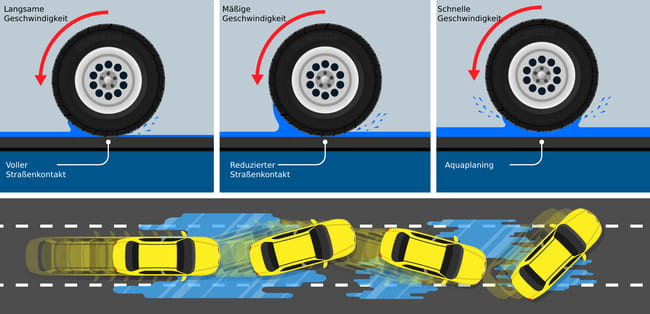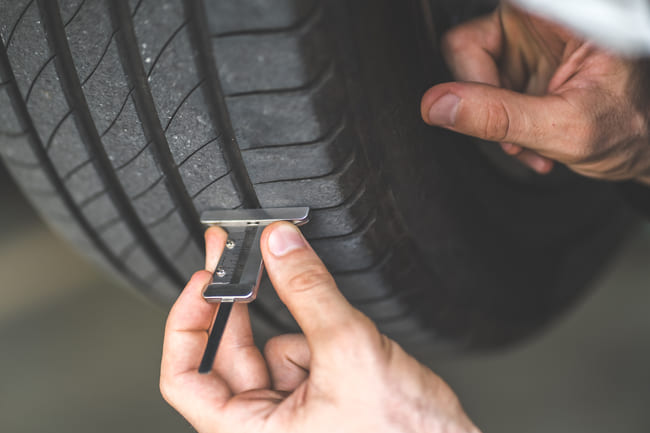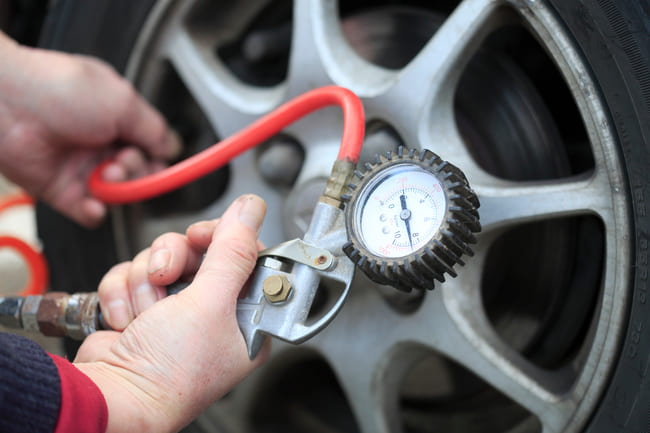
Aquaplaning can quickly lead to serious accidents. This is because this effect causes your tires to lose the grip they need with the road surface. The most common time you are confronted with aquaplaning with your car is when it is raining heavily. This is particularly the case in autumn, so accidents like this usually happen at this time of the year. Avoiding icy water is also the reason why we have to slow down in heavy rain.
Contents
What is Aquaplaning?
One speaks of aquaplaning or slippery water when one or more of your tires „float“ on a wet road surface. and thus lose their adhesion to the substrate. So you can say that the corresponding amounts of water form a kind of wedge if they can no longer be displaced by the tire or drained through its profile. Since you can no longer steer or brake your vehicle and it no longer behaves as desired (similar to skidding), aquaplaning quickly leads to an accident. The reason for the lack of steerability and poor braking behavior is that the corresponding forces are no longer transmitted from the tires to the road surface, as actually desired, but only to the water film.
What can lead to aquaplaning (slippery water) on wet roads?

There are a number of factors that can influence the occurrence of slippery water or aquaplaning. First of all, it always has to be wet, otherwise the dangerous water film cannot form in the first place. This also means that the risk of aquaplaning increases when the water to be driven through or the water standing on the road is deeper. Ultimately, with greater water depth (higher water film thickness), your car tires have to displace significantly more water in order to still offer optimal road grip. So if there is a lot of water and it cannot drain off immediately, the risk of an accident increases significantly.
Another very important factor in hydroplaning is the speed at which you are traveling. Put simply, this is also about the physical displacement of the water. If you drive faster, the existing water has to be displaced faster; in other words, the likelihood of a dangerous wedge of water forming in front of your tires increases. On the other hand, if you drive more slowly, the water can be displaced more easily to the left and right and road holding is significantly improved. This is also the reason why you have to slow down in heavy rain.

Tire tread depth also belongs in the same category of risk factors. So it is logical that a deeper profile can absorb larger amounts of water more easily and also transport them away or displace them. It becomes critical when the tread depth of your tires falls below a certain value. For example, a minimum tread depth of 3 millimeters is assumed for summer tires and a minimum tread depth of 4 millimeters for winter tires. If your tires fall below this value, we recommend that you replace them. Even if it is legally permitted to wear the tires even further (up to 1.6 millimetres), we strongly advise against exploiting this limit. Otherwise, don't be surprised if you soon start struggling with aquaplaning, even at low speeds.
Looking at statistics alone, freeways and interurban roads are more likely to hydroplan than inner-city roads. The speed that is driven there plays a particularly important role. The road surface used is secondary. In general, however, a lower gradient of the road, but also curves, depressions or underpasses favor the occurrence of slippery water. When asked where aquaplaning occurs particularly frequently, the answer is motorways and country roads for another reason: On routes that are used particularly frequently by trucks (especially the right-hand lanes of the motorway), ruts often appear in the road. Water can also easily collect there, which can also lead to aquaplaning on the motorway.
Aquaplaning is also more likely with wide tires, because they have a larger contact area, so that the contact pressure on the road is reduced. When buying such tyres, it is therefore worth making sure that you choose models whose manufacturers reduce the risk of aquaplaning through special profiles (especially in the edge area).

An insufficient one has a similar negative impact tire pressure. If this is too low, the car tire becomes more sluggish, which significantly reduces water displacement.
What causes aquaplaning and what other critical safety systems are there in your vehicle?
If you hear loud water noise coming from your fender or if you can steer your vehicle particularly easily, then these are absolute warning signs that there is a high risk of slippery water. In addition, your engine speed may increase unexpectedly without the vehicle accelerating and the ESP light will illuminate. At this point at the latest, you should carefully reduce your driving speed. It may also be necessary to stand still until the rain has stopped. Once you have started to skid, you should act prudently and know what to do in the event of aquaplaning in order to avoid major accidents. Hold your steering wheel with both hands, gently take your foot off the accelerator pedal and, in conjunction with the brake, slowly reduce the speed. Step on the clutch. Also note that you should neither brake hard nor steer hastily.
If none of this helps and an accident occurs, you can rely on your SRS and also the airbags. Together they ensure that you are not injured or at least less seriously injured in an accident.
Conclusion
Even if you always drive carefully, you are not always immune to aquaplaning. You should therefore always keep an eye on the warning lights, such as the ESP, when driving, as they can warn you of the impending danger. In addition, the child safety device is of great importance in addition to securing the other occupants when driving. After all, you don't want to blame yourself later if something happens.
A tip from CarTipsandmore: Prevention is better than aftercare! You should always avoid slippery water. Aquaplaning can even occur at level crossings, because the road surface there is usually different. In addition to reducing your speed, your tires naturally have the greatest impact as a preventive measure. So you should always pay attention to good wet grip when purchasing and replace these vehicle parts promptly if the profile is less than three (summer tires) or four (winter tires) millimeters deep. You should also pay attention to defective shock absorbers, as these can greatly aggravate the consequences of aquaplaning.
